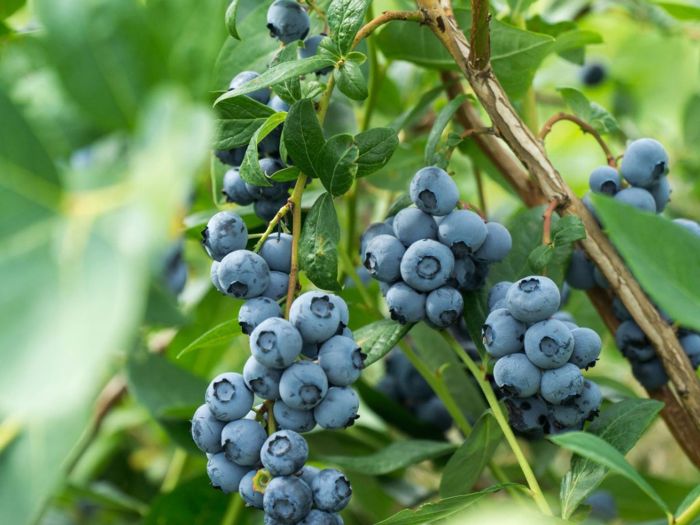How to Plant a Blueberry Seed
Blueberry Seed Planting: A Comprehensive Guide
How to plant a blueberry seed – Cultivating blueberries from seed presents a rewarding challenge for the home gardener. While not the quickest method, it offers a unique connection to the growth process and the satisfaction of nurturing a plant from its very beginning. This guide will walk you through each stage, from seed acquisition to a thriving young blueberry plant.
Seed Acquisition and Preparation

Source: tipsbulletin.com
Successfully growing blueberries from seed begins with selecting and preparing high-quality seeds. Ideal blueberry seeds are plump, firm, and free from blemishes or discoloration. They should be extracted from fully ripe berries for the best germination rates.
Obtaining blueberry seeds involves carefully extracting them from ripe, preferably wild, blueberries. Begin by thoroughly washing the berries to remove any adhering debris. Gently mash the berries to release the seeds, then strain them through a fine-mesh sieve to separate the seeds from the pulp. Rinse the seeds thoroughly to remove all traces of pulp, as this can hinder germination.
Seed preparation involves a process called stratification, which mimics the natural winter conditions that seeds experience in their environment. This cold treatment breaks seed dormancy and significantly improves germination rates. To stratify blueberry seeds, mix them with slightly damp vermiculite or peat moss in a sealed container. Store the container in the refrigerator (between 33°F and 41°F) for 60-90 days.
This period allows the seeds to undergo the necessary chilling process before planting.
Sowing the Seeds, How to plant a blueberry seed
Choosing the right planting medium is crucial for successful blueberry seed germination. A well-draining, sterile mix is ideal, such as a blend of peat moss, perlite, and vermiculite. Avoid using garden soil directly, as it may contain pathogens that can harm the delicate seedlings.
Blueberry seeds can be sown using two primary methods: direct sowing or using seed trays. Direct sowing involves planting the seeds directly into the final growing container. Seed trays offer better control over the environment and make it easier to manage seedlings in their early stages. Each method has advantages and disadvantages.
| Method | Advantages | Disadvantages | Success Rate (Estimated) |
|---|---|---|---|
| Direct Sowing | Less transplanting stress, potentially faster growth | Higher risk of seedling loss, less control over environment | 50-60% |
| Seed Trays | Greater control over environment, easier seedling management, lower risk of damping-off | Requires transplanting, slightly slower initial growth | 60-70% |
Germination and Seedling Care

Source: gardeningknowhow.com
Optimal conditions for blueberry seed germination include a warm temperature (around 70-75°F), bright but indirect light, and consistently moist (but not waterlogged) soil. Maintaining consistent moisture is critical during germination; the seeds need adequate hydration to sprout. Overwatering, however, can lead to damping-off, a fungal disease that can kill seedlings.
Successful germination is indicated by the emergence of tiny, delicate seedlings with their characteristic cotyledons (seed leaves). Damping-off manifests as wilting and rotting of seedlings at the soil line. Good air circulation and avoiding overwatering can help prevent this.
A watering schedule for blueberry seedlings should involve checking the soil moisture daily. Water when the top inch of the soil feels dry to the touch, ensuring the soil is consistently moist but not soggy. Regular monitoring for signs of disease or pests is also crucial.
Transplanting Seedlings
Blueberry seedlings are ready for transplanting when they have developed several true leaves (leaves that are different from the cotyledons) and are about 2-3 inches tall. This typically occurs several weeks after germination. Careful handling is essential during transplanting to minimize stress on the delicate root systems.
The transplanting process involves gently removing seedlings from their original containers, taking care not to damage their roots. Prepare individual pots or a garden bed by amending the soil with organic matter like compost to improve drainage and fertility. Plant the seedlings at the same depth they were growing in their original containers, ensuring good soil contact around the roots.
Minimizing transplant shock involves handling the seedlings gently, providing adequate watering immediately after transplanting, and shielding them from direct sunlight for a few days to allow them to adjust to their new environment.
Ongoing Care and Growth
Ongoing care for young blueberry plants involves providing consistent watering, fertilization, and protection from pests and diseases. Blueberries thrive in acidic soil (pH 4.5-5.5) with excellent drainage and rich in organic matter. They require regular fertilization, ideally with a fertilizer formulated for acid-loving plants.
- Water regularly, keeping the soil consistently moist but not waterlogged.
- Fertilize every 2-4 weeks during the growing season with an acid-loving plant fertilizer.
- Monitor for pests and diseases, treating promptly if necessary.
- Mulch around the plants to conserve moisture and suppress weeds.
- Prune lightly to remove dead or damaged branches.
Pruning young blueberry plants helps to promote healthy growth and shape. Remove any dead, damaged, or crossing branches. This encourages air circulation and prevents disease. Light pruning is best for young plants; more significant pruning can be done as the plants mature.
Visual Guide: Seedling Development

Source: somuchviral.com
Blueberry seedling development progresses through distinct stages. Initially, the seed germinates, sending out a small root and a shoot bearing the cotyledons. These cotyledons are small, oval, and provide initial nourishment to the seedling. As the seedling grows, true leaves emerge, typically ovate to elliptical in shape, with serrated edges. The stems are initially slender and green, gradually becoming more woody as the plant matures.
The leaves darken in color and become more robust as the plant develops. With proper care, you’ll observe a gradual transition from a tiny sprout to a sturdy young blueberry plant.
Common Queries: How To Plant A Blueberry Seed
Can I use store-bought blueberries to get seeds?
Yes, but choose organically grown berries to avoid pesticide residues. Make sure they are fully ripe.
How long does it take for blueberry seeds to germinate?
Germination can take several weeks to several months, depending on conditions and seed viability.
Planting blueberry seeds requires patience and the right conditions. Similar to the process for other fruits, successful germination depends on careful preparation. For a comprehensive guide on a related fruit, check out this article on how to plant guava seeds , which offers insights into seed preparation and optimal planting techniques. Applying some of these principles can also improve your blueberry seed planting success rate.
What should I do if my seedlings develop damping-off?
Improve air circulation, reduce watering, and consider using a fungicide if necessary. Remove affected seedlings.
When can I expect my blueberry plants to produce fruit?
It typically takes 3-5 years for blueberry plants grown from seed to produce a significant harvest.




















